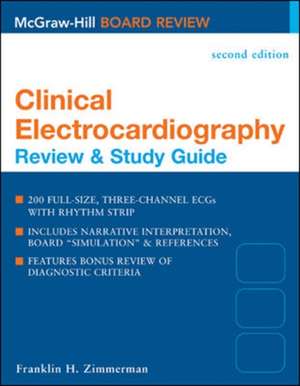Clinical Electrocardiography: Review & Study Guide, Second Edition
Autor Franklin Zimmermanen Limba Engleză Paperback – 16 apr 2004
The most effective self-assessment tool for any clinician who interprets ECGs!This unique resource offers 200 full-sized, three-channel ECGs with lead II rhythm strips, in a format that parallels the cardiology board exam. Each ECG is accompanied by a brief clinical history and followed by a narrative interpretation and board simulation, along with references for further study. A special bonus is the comprehensive section that provides diagnostic criteria for common electrocardiographic diagnoses.
Features:
*Perfect for boards in cardiology, critical care, and anesthesiology–or for clinical practice
*200 full-size, three-channel ECGs with rhythm strip
*Each ECG accompanied by a brief clinical history in board format
*Narrative and board-type interpretations on facing page
*ECGs range from simple to complex, reflecting conditions both common and rare
*Review of diagnostic criteria for common electrocardiographic diagnoses included
*References provided for further research or study
The ultimate study aid for certification, re-certification, CME–or as a clinical refresher–this unique skill- and knowledge-building tool will help you to hone your skills in interpreting cardiac arrhythmias and other electrocardiographic abnormalities, as well as help you to effectively correlate ECG data with clinical information. More than just a study guide, this one-of-a-kind resource includes reference material that every electrocardiographer will find useful in daily clinical practice.
Preț: 740.62 lei
Preț vechi: 779.59 lei
-5% Nou
Puncte Express: 1111
Preț estimativ în valută:
141.76€ • 154.04$ • 119.16£
141.76€ • 154.04$ • 119.16£
Carte tipărită la comandă
Livrare economică 21 aprilie-05 mai
Preluare comenzi: 021 569.72.76
Specificații
ISBN-13: 9780071423021
ISBN-10: 0071423028
Pagini: 421
Dimensiuni: 213 x 274 x 17 mm
Greutate: 0.9 kg
Ediția:2
Editura: McGraw Hill Education
Colecția McGraw Hill / Medical
Locul publicării:United States
ISBN-10: 0071423028
Pagini: 421
Dimensiuni: 213 x 274 x 17 mm
Greutate: 0.9 kg
Ediția:2
Editura: McGraw Hill Education
Colecția McGraw Hill / Medical
Locul publicării:United States


























